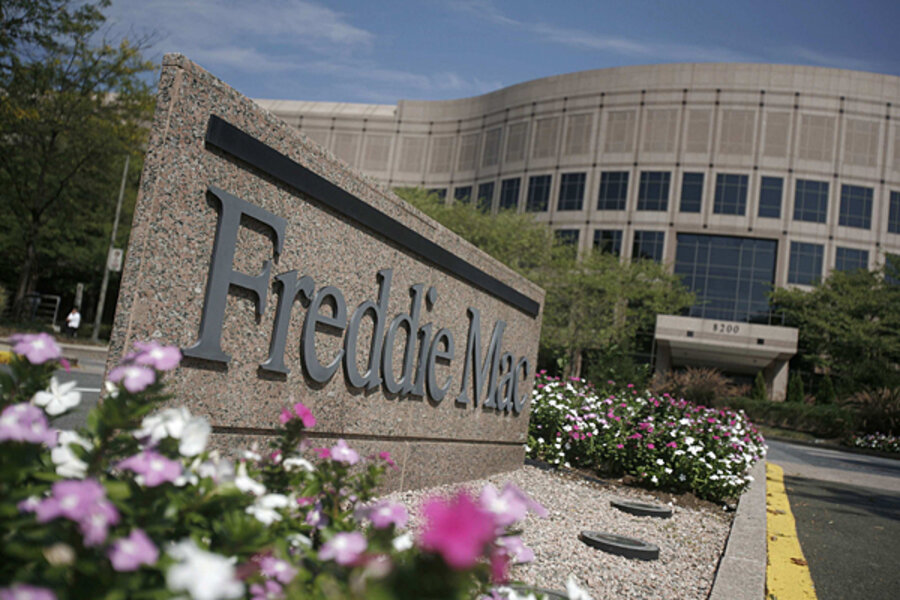Phase out Fannie Mae and Freddie Mac? Here's White House's plan.
Loading...
What to do about the mortgage market may be the largest unaddressed question from the economic downturn. The mortgage market is still heavily reliant on loan guarantees from Fannie Mae and Freddie Mac, the giant corporations brought under government conservatorship in 2008 in a costly taxpayer bailout.
Lawmakers are looking for ways to dial back the government's role in propping up the mortgage markets – just as it looked for ways to exit its bank bailouts in past years. How that happens has major implications for the mortgage market and the economy. On Friday, the Treasury and Housing Departments released
their long-anticipated report on the subject. It calls for phasing out Fannie and Freddie and charting a new US housing policy.
Here are highlights from the report, with notes to help explain what it all means.
First, the report offers the administration's take on why the existing system failed. Here's a summary paragraph:
In the past, the government's financial and tax policies encouraged housing purchases and real estate investment over other sectors of our economy, and ultimately left taxpayers responsible for much of the risk incurred by a poorly supervised housing finance market.
So the administration wants gradually to phase out Fannie Mae and Freddie Mac. Why not just get government out of housing markets entirely? The report says government still has some important roles to play.
Going forward, the government's primary role should be limited to robust oversight and consumer protection, targeted assistance for low-and moderate-income homeowners and renters, and carefully designed support for market stability and crisis response.
Translating those goals into specifics means choosing: Just how active should the government be? The report gives three options, starting with what the administration sees as a minimalist option 1: Sharply curb government's role in mortgages.
This option would dramatically reduce the government's role in insuring or guaranteeing mortgages, limiting it to FHA and other programs targeted to creditworthy lower- and moderate-income borrowers.
The strength of this option is that it would minimize distortions.... With less incentive to invest in housing, more capital will flow into other areas of the economy, potentially leading to more long-run economic growth and reducing the inflationary pressure on housing assets."
Option 1 has drawbacks, officials acknowledge. One is that loans will cost more for typical borrowers. Another is the lack of contingency plans for a crisis. The absence of a plan, the administration hints, could raise the odds that government would feel compelled to offer the worst kind support – bailouts for banks.
While mortgage rates are likely to rise somewhat under any responsible reform proposal, including the three outlined here, the effect could be larger under this option....
Another concern with this option is the ability of the government to effectively step in to ensure access to capital during a crisis.... A related risk would exist if investors believe that the government would inevitably step in to save whatever private financial institutions or banks have become necessary to maintain the flow of mortgage credit. If so, this option will potentially fail to eliminate the risk of moral hazard.
So ... they offer option 2: Support the mortgage market in a crisis.
As in the option above, FHA and other narrowly targeted programs would provide access to mortgage credit for low- and moderate-income borrowers.... In this option, however, the government would also develop a backstop mechanism to ensure access to credit during a housing crisis....
[One] approach would restrict the amount of public insurance [of mortgages] sold to the private market in normal times, but allow the amount of insurance offered to ramp up to stabilize the market in times of stress....
The drawback: Again, mortgage rates rise for most borrowers.
Access to credit ... would likely be more expensive under this option than under [the next option].
What about option 3? It calls for a larger government role than in options 1 or 2, with the aim of keeping mortgage rates lower for the average borrower and having stronger supports in place during a crisis. The government would offer a permanent backstop for many mortgages, but would cover costs with fees (to protect taxpayers).
Under this option, as in the previous options, the mortgage market ... would be driven [mainly] by private investment decisions with private capital taking the primary credit risk. However, to increase ... access to mortgages for creditworthy Americans – as well as to ensure the government's ability to respond to future crises – the government would offer reinsurance for the securities of a targeted range of mortgages....
The government reinsurer would charge a premium ... which would be used to cover future claims and recoup losses to protect taxpayers....
This plan comes with its own drawback: the risk that the program could be mismanaged in ways that harm the economy or taxpayers.
If the oversight of the private mortgage guarantors is inadequate or the pricing of the reinsurance too low ... then private actors in the market may take on excessive risk and the taxpayer could again bear the cost.
Can any of these plans actually be implemented, with the housing market still struggling under a flood of foreclosures? The administration answers yes, but not to expect a quick legislative deal. Rather, it will take time for Congress to decide on a replacement system – and some years to wind down Fannie and Freddie.
We ask Congress to work with us ... as soon as possible. Reform will not come overnight. Some reforms can take place immediately, like improvements to consumer protection and government oversight, while others will be implemented more gradually as the housing market heals....
Prematurely constraining Fannie Mae and Freddie Mac's ability to guarantee loans or precipitously winding them down could limit the availability of mortgage credit, shock the housing market, and expose taxpayers to additional losses on the loans Fannie Mae and Freddie Mac already guarantee.





